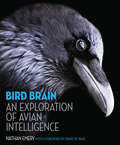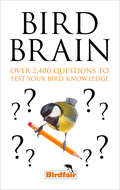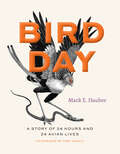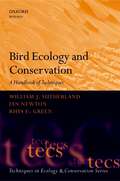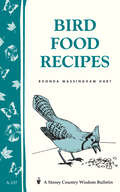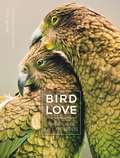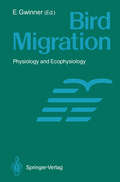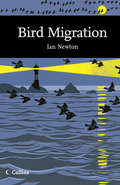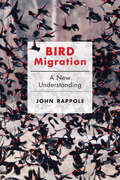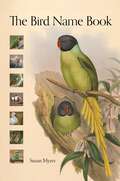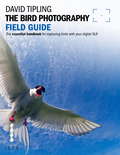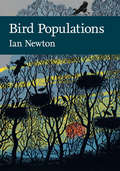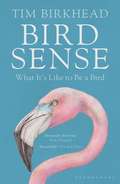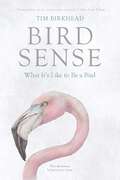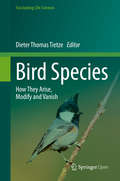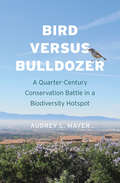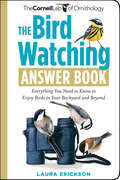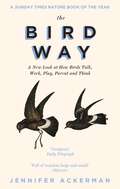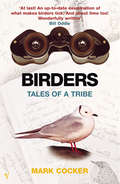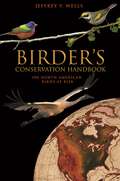- Table View
- List View
Bird Brain: An Exploration of Avian Intelligence
by Nathan Emery Frans De WaalBirds have not been known for their high IQs, which is why a person of questionable intelligence is sometimes called a "birdbrain." Yet in the past two decades, the study of avian intelligence has witnessed dramatic advances. From a time when birds were seen as simple instinct machines responding only to stimuli in their external worlds, we now know that some birds have complex internal worlds as well. This beautifully illustrated book provides an engaging exploration of the avian mind, revealing how science is exploding one of the most widespread myths about our feathered friends—and changing the way we think about intelligence in other animals as well.Bird Brain looks at the structures and functions of the avian brain, and describes the extraordinary behaviors that different types of avian intelligence give rise to. It offers insights into crows, jays, magpies, and other corvids—the “masterminds” of the avian world—as well as parrots and some less-studied species from around the world. This lively and accessible book shows how birds have sophisticated brains with abilities previously thought to be uniquely human, such as mental time travel, self-recognition, empathy, problem solving, imagination, and insight.Written by a leading expert and featuring a foreword by Frans de Waal, renowned for his work on animal intelligence, Bird Brain shines critical new light on the mental lives of birds.
Bird Brain: Over 2,400 Questions To Test Your Bird Knowledge
by William CollinsAn ornithological quiz book packed with challenging questions for birders, based on the popular ‘Bird Brain of Britain’ contest at the annual BirdFair.
Bird Day: A Story of 24 Hours and 24 Avian Lives (Earth Day)
by Mark E. HauberAn hourly guide that follows twenty-four birds as they find food, mates, and safety from predators. From morning to night and from the Antarctic to the equator, birds have busy days. In this short book, ornithologist Mark E. Hauber shows readers exactly how birds spend their time. Each chapter covers a single bird during a single hour, highlighting twenty-four different bird species from around the globe, from the tropics through the temperate zones to the polar regions. We encounter owls and nightjars hunting at night and kiwis and petrels finding their way in the dark. As the sun rises, we witness the beautiful songs of the “dawn chorus.” At eleven o’clock in the morning, we float alongside a common pochard, a duck resting with one eye open to avoid predators. At eight that evening, we spot a hawk swallowing bats whole, gorging on up to fifteen in rapid succession before retreating into the darkness. For each chapter, award-winning artist Tony Angell has depicted these scenes with his signature pen and ink illustrations, which grow increasingly light and then dark as our bird day passes. Working closely together to narrate and illustrate these unique moments in time, Hauber and Angell have created an engaging read that is a perfect way to spend an hour or two—and a true gift for readers, amateur scientists, and birdwatchers.
Bird Day: A Story of 24 Hours and 24 Avian Lives (Earth Day)
by Mark E. HauberAn hourly guide that follows twenty-four birds as they find food, mates, and safety from predators. From morning to night and from the Antarctic to the equator, birds have busy days. In this short book, ornithologist Mark E. Hauber shows readers exactly how birds spend their time. Each chapter covers a single bird during a single hour, highlighting twenty-four different bird species from around the globe, from the tropics through the temperate zones to the polar regions. We encounter owls and nightjars hunting at night and kiwis and petrels finding their way in the dark. As the sun rises, we witness the beautiful songs of the “dawn chorus.” At eleven o’clock in the morning, we float alongside a common pochard, a duck resting with one eye open to avoid predators. At eight that evening, we spot a hawk swallowing bats whole, gorging on up to fifteen in rapid succession before retreating into the darkness. For each chapter, award-winning artist Tony Angell has depicted these scenes with his signature pen and ink illustrations, which grow increasingly light and then dark as our bird day passes. Working closely together to narrate and illustrate these unique moments in time, Hauber and Angell have created an engaging read that is a perfect way to spend an hour or two—and a true gift for readers, amateur scientists, and birdwatchers.
Bird Ecology and Conservation: A Handbook of Techniques (Techniques in Ecology & Conservation #1)
by William J. Sutherland Ian Newton Rhys GreenThe aim of this book is to outline the main methods and techniques available to ornithologists. A general shortage of information about available techniques is greatly hindering progress in avian ecology and conservation. Currently this sort of information is disparate and difficult to locate with much of it widely dispersed in books, journals and grey literature. Sutherland and his editorial team bring together in a single authoritative source all the ornithological techniques the avian community will ever need. For use by graduate students, researchers and practising conservationists worldwide. Bird Ecology and Conservation is the first title in a new series of practical handbooks which include titles focusing on specific taxonomic groups as well as those describing broader themes and subjects. The series editor is William J Sutherland.
Bird Food Recipes: Storey Country Wisdom Bulletin A-137 (Storey Country Wisdom Bulletin)
by Rhonda Massingham HartSince 1973, Storey's Country Wisdom Bulletins have offered practical, hands-on instructions designed to help readers master dozens of country living skills quickly and easily. There are now more than 170 titles in this series, and their remarkable popularity reflects the common desire of country and city dwellers alike to cultivate personal independence in everyday life.
Bird Love: The Family Life of Birds
by Wenfei TongA stunningly illustrated look at the mating and parenting lives of the world's birdsBird Love looks at the extraordinary range of mating systems in the avian world, exploring all the stages from courtship and nest-building to protecting eggs and raising chicks. It delves into the reasons why some species, such as the wattled jacana, rely on males to do all the childcare, while others, such as cuckoos and honeyguides, dump their eggs in the nests of others to raise. For some birds, reciprocal promiscuity pays off: both male and female dunnocks will rear the most chicks by mating with as many partners as possible. For others, long-term monogamy is the only way to ensure their offspring survive.The book explores the wide variety of ways birds make sure they find a mate in the first place, including how many male birds employ elaborate tactics to show how sexy they are. Gathering in leks to display to females, they dance, pose, or parade to sell their suitability as a mate. Other birds attract a partner with their building skills: female bowerbirds rate brains above beauty, so males construct elaborate bowers with twig avenues and cleared courtyards to impress them.Looking at the differing levels of parenting skills across species around the world, we see why a tenth of bird species, including the fairy-wrens of Australia, have helpers at the nest who forgo their own reproduction to assist the breeding pair; how brood parasites and their hosts have engaged in evolutionary arms races; and how monogamous pairs share—or relinquish—their responsibilities.Illustrated throughout with beautiful photographs, Bird Love is a celebration of the global diversity of avian reproductive strategies.
Bird Love: The Family Life of Birds (PDF)
by Wenfei TongA stunningly illustrated look at the mating and parenting lives of the world's birdsBird Love looks at the extraordinary range of mating systems in the avian world, exploring all the stages from courtship and nest-building to protecting eggs and raising chicks. It delves into the reasons why some species, such as the wattled jacana, rely on males to do all the childcare, while others, such as cuckoos and honeyguides, dump their eggs in the nests of others to raise. For some birds, reciprocal promiscuity pays off: both male and female dunnocks will rear the most chicks by mating with as many partners as possible. For others, long-term monogamy is the only way to ensure their offspring survive.The book explores the wide variety of ways birds make sure they find a mate in the first place, including how many male birds employ elaborate tactics to show how sexy they are. Gathering in leks to display to females, they dance, pose, or parade to sell their suitability as a mate. Other birds attract a partner with their building skills: female bowerbirds rate brains above beauty, so males construct elaborate bowers with twig avenues and cleared courtyards to impress them.Looking at the differing levels of parenting skills across species around the world, we see why a tenth of bird species, including the fairy-wrens of Australia, have helpers at the nest who forgo their own reproduction to assist the breeding pair; how brood parasites and their hosts have engaged in evolutionary arms races; and how monogamous pairs share—or relinquish—their responsibilities.Illustrated throughout with beautiful photographs, Bird Love is a celebration of the global diversity of avian reproductive strategies.
Bird Migration: Physiology and Ecophysiology
by Eberhard GwinnerE. GWINNER! The phenomenon of bird migration with its large scale dimensions has attracted the attention of naturalists for centuries. Worldwide billions of birds leave their breeding grounds every autumn to migrate to areas with seasonally more favor able conditions. Many of these migrants travel only over a few hundred kilo meters but others cover distances equivalent to the circumference of the earth. Among these long-distance migrants are several billion birds that invade Africa every autumn from their West and Central Palaearctic breeding areas. In the Americas and in Asia the scope of bird migration is of a similar magnitude. Just as impressive as the numbers of birds are their achievements. They have to cope with the enormous energetic costs of long-distance flying. particularly while crossing oceans and deserts that do not allow replenishment of depleted fat reserves. They have to appropriately time the onset and end of migrations. both on a daily and annual basis. And finally. they have to orient their migratory movements in space to reach their species- or population-specific wintering and breeding grounds, irrespective of the variable climatic conditions along their migratory routes.
Bird Migration (Collins New Naturalist Library #113)
by Ian NewtonThe phenomenon of bird migration has fascinated people from time immemorial. The arrivals and departures of different species marked the seasons, heralding spring and autumn, and providing a reliable calendar long before anything better became available.
Bird Migration: A New Understanding
by John H. RappoleA fascinating and nuanced exploration of why, how, and which birds migrate.Bird migration captivates the human imagination, yet for most of us, key aspects of the phenomenon remain a mystery. How do birds sense the ideal moment to take wing, and once the epic journey has begun, how do they find their distant destinations? Fresh insights about avian movements are still constantly emerging, powered by new tools like molecular genetics and transmitter miniaturization. In this book, renowned ornithologist and author John H. Rappole reveals intriguing results of recent scientific studies on migration, explaining their importance for birders, nature lovers, and researchers alike. Debunking misconceptions about the lives of birds that have persisted for thousands of years, Rappole explores unexpected causes and previously misunderstood aspects of the annual migration cycle. From the role of migrating birds in zoonotic disease transmission to climate change's impact on migration patterns, Rappole tackles crucial questions and ensures that readers come away with a new understanding of why and how birds migrate.
Bird Migration: A New Understanding
by John H. RappoleA fascinating and nuanced exploration of why, how, and which birds migrate.Bird migration captivates the human imagination, yet for most of us, key aspects of the phenomenon remain a mystery. How do birds sense the ideal moment to take wing, and once the epic journey has begun, how do they find their distant destinations? Fresh insights about avian movements are still constantly emerging, powered by new tools like molecular genetics and transmitter miniaturization. In this book, renowned ornithologist and author John H. Rappole reveals intriguing results of recent scientific studies on migration, explaining their importance for birders, nature lovers, and researchers alike. Debunking misconceptions about the lives of birds that have persisted for thousands of years, Rappole explores unexpected causes and previously misunderstood aspects of the annual migration cycle. From the role of migrating birds in zoonotic disease transmission to climate change's impact on migration patterns, Rappole tackles crucial questions and ensures that readers come away with a new understanding of why and how birds migrate.
The Bird Name Book: A History of English Bird Names
by Susan MyersA marvelously illustrated A-to-Z compendium of bird names from around the globeThe Bird Name Book is an alphabetical reference book on the origins and meanings of common group bird names, from “accentor” to “zeledonia.” A cornucopia of engaging facts and anecdotes, this superbly researched compendium presents a wealth of incisive entries alongside stunning photos by the author and beautiful historic prints and watercolors. Myers provides brief biographies of prominent figures in ornithology—such as John Gould, John Latham, Alfred Newton, and Robert Ridgway—and goes on to describe the etymological history of every common group bird name found in standardized English. She interweaves the stories behind the names with quotes from publications dating back to the 1400s, illuminating the shared evolution of language and our relationships with birds, and rooting the names in the history of ornithological discovery.Whether you are a well-traveled birder or have ever wondered how the birds in your backyard got their names, The Bird Name Book is an ideal companion.
The Bird Name Book: A History of English Bird Names
by Susan MyersA marvelously illustrated A-to-Z compendium of bird names from around the globeThe Bird Name Book is an alphabetical reference book on the origins and meanings of common group bird names, from “accentor” to “zeledonia.” A cornucopia of engaging facts and anecdotes, this superbly researched compendium presents a wealth of incisive entries alongside stunning photos by the author and beautiful historic prints and watercolors. Myers provides brief biographies of prominent figures in ornithology—such as John Gould, John Latham, Alfred Newton, and Robert Ridgway—and goes on to describe the etymological history of every common group bird name found in standardized English. She interweaves the stories behind the names with quotes from publications dating back to the 1400s, illuminating the shared evolution of language and our relationships with birds, and rooting the names in the history of ornithological discovery.Whether you are a well-traveled birder or have ever wondered how the birds in your backyard got their names, The Bird Name Book is an ideal companion.
The Bird Photography Field Guide: The Essential Handbook for Capturing Birds with your digital SLR (Field Guide)
by David TiplingA specialist title aimed at bird watchers, this handy book contains all the expertise you need to make your bird-watching trip into a rewarding photo session: there is copious advice on equipment, technique and field craft, and a wealth of wonderful photos to inspire you. Finally, a section on the digital darkroom will help you turn your shots into perfect prints.
Bird Populations (Collins New Naturalist Library #124)
by Ian NewtonIn the latest addition to the New Naturalist series, Ian Newton explores bird populations and what causes their fluctuation – food supplies, competitors, predators, parasites, pathogens and human activity.
Bird Sense: What It's Like to Be a Bird
by Tim BirkheadWhat is it like to be a swift, flying at over one hundred kilometres an hour? Or a kiwi, plodding flightlessly among the humid undergrowth in the pitch dark of a New Zealand night? And what is going on inside the head of a nightingale as it sings, and how does its brain improvise? Bird Sense addresses questions like these and many more, by describing the senses of birds that enable them to interpret their environment and to interact with each other. Our affinity for birds is often said to be the result of shared senses - vision and hearing - but how exactly do their senses compare with our own? And what about a birds' sense of taste, or smell, or touch or the ability to detect the earth's magnetic field? Or the extraordinary ability of desert birds to detect rain hundreds of kilometres away - how do they do it? Bird Sense is based on a conviction that we have consistently underestimated what goes on in a bird's head. Our understanding of bird behaviour is simultaneously informed and constrained by the way we watch and study them. By drawing attention to the way these frameworks both facilitate and inhibit discovery, it identifies ways we can escape from them to seek new horizons in bird behaviour. There has never been a popular book about the senses of birds. No one has previously looked at how birds interpret the world or the way the behaviour of birds is shaped by their senses. A lifetime spent studying birds has provided Tim Birkhead with a wealth of observation and an understanding of birds and their behaviour that is firmly grounded in science.
Bird Sense: What It's Like to Be a Bird
by Tim BirkheadWhat is it like to be a swift, flying at over one hundred kilometres an hour? Or a kiwi, plodding flightlessly among the humid undergrowth in the pitch dark of a New Zealand night? And what is going on inside the head of a nightingale as it sings, and how does its brain improvise?Bird Sense addresses questions like these and many more, by describing the senses of birds that enable them to interpret their environment and to interact with each other. Our affinity for birds is often said to be the result of shared senses--vision and hearing--but how exactly do their senses compare with our own? And what about a bird's sense of taste, or smell, or touch, or the ability to detect the earth's magnetic field? Or the extraordinary ability of desert birds to detect rain hundreds of kilometres away--how do they do it?Bird Sense is based on a conviction that we have consistently underestimated what goes on in a bird's head. Our understanding of bird behaviour is simultaneously informed and constrained by the way we watch and study them. By drawing attention to the way these frameworks both facilitate and inhibit discovery, Birkhead identifies ways we can escape from them to explore new horizons in bird behaviour. There has never been a popular book about the senses of birds. No one has previously looked at how birds interpret the world or the way the behaviour of birds is shaped by all their senses. A lifetime spent studying birds has provided Tim Birkhead with a wealth of observation and a unique understanding of birds and their behaviour that is firmly grounded in science.
Bird Species: How They Arise, Modify And Vanish (Fascinating Life Sciences)
by Dieter Thomas TietzeThe average person can name more bird species than they think, but do we really know what a bird “species” is? This open access book takes up several fascinating aspects of bird life to elucidate this basic concept in biology. From genetic and physiological basics to the phenomena of bird song and bird migration, it analyzes various interactions of birds – with their environment and other birds. Lastly, it shows imminent threats to birds in the Anthropocene, the era of global human impact. Although it seemed to be easy to define bird species, the advent of modern methods has challenged species definition and led to a multidisciplinary approach to classifying birds. One outstanding new toolbox comes with the more and more reasonably priced acquisition of whole-genome sequences that allow causative analyses of how bird species diversify. Speciation has reached a final stage when daughter species are reproductively isolated, but this stage is not easily detectable from the phenotype we observe. Culturally transmitted traits such as bird song seem to speed up speciation processes, while another behavioral trait, migration, helps birds to find food resources, and also coincides with higher chances of reaching new, inhabitable areas. In general, distribution is a major key to understanding speciation in birds. Examples of ecological speciation can be found in birds, and the constant interaction of birds with their biotic environment also contributes to evolutionary changes. In the Anthropocene, birds are confronted with rapid changes that are highly threatening for some species. Climate change forces birds to move their ranges, but may also disrupt well-established interactions between climate, vegetation, and food sources. This book brings together various disciplines involved in observing bird species come into existence, modify, and vanish. It is a rich resource for bird enthusiasts who want to understand various processes at the cutting edge of current research in more detail. At the same time it offers students the opportunity to see primarily unconnected, but booming big-data approaches such as genomics and biogeography meet in a topic of broad interest. Lastly, the book enables conservationists to better understand the uncertainties surrounding “species” as entities of protection.
Bird versus Bulldozer: A Quarter-Century Conservation Battle in a Biodiversity Hotspot
by Audrey MayerAn examination of the struggle to conserve biodiversity in urban regions, told through the story of the threatened coastal California gnatcatcher The story of the rare coastal California gnatcatcher is a parable for understanding the larger ongoing struggle to conserve biodiversity in regions confronted with intensifying urban development. Because this gnatcatcher depends on vanishing coastal sage scrub in Southern California, it has been regarded as a flagship species for biodiversity protection since the early 1990s. But the uncertainty of the gnatcatcher’s taxonomic classification—and whether it can be counted as a “listable unit” under the Endangered Species Act—has provoked contentious debate among activists, scientists, urban developers, and policy makers. Synthesizing insights from ecology, environmental history, public policy analysis, and urban planning as she tracks these debates over the course of the past twenty-five years, Audrey L. Mayer presents an ultimately optimistic take on the importance of much-neglected regional conservation planning strategies to create sustainable urban landscapes that benefit humans and wildlife alike.
The Bird Watching Answer Book: Everything You Need to Know to Enjoy Birds in Your Backyard and Beyond
by Laura EricksonLearn the how&’s and why&’s of bird behavior, from flirtatious mating practices and gorgeous birdsong to flying south for the winter. In this lively reference book, Laura Erickson addresses hundreds of real-life questions sent in to the Cornell Lab of Ornithology, the world&’s foremost authority on birds. With expert advice on bird watching techniques and equipment, feeding and housing birds, protecting habitats, and much more, Erickson guides you through the intricacies of the avian world with a contagious passion for our feathered friends.
The Bird Way: A New Look at How Birds Talk, Work, Play, Parent, and Think
by Jennifer AckermanFrom the New York Times bestselling author of The Genius of Birds, a radical investigation into the bird way of being, and the recent scientific research that is dramatically shifting our understanding of birds. 'There is the mammal way and there is the bird way.' This is one scientist's pithy distinction between mammal brains and bird brains: two ways to make a highly intelligent mind. But lately, scientists have taken a new look at bird behaviours they've previously dismissed as anomalies. What they're finding is upending the traditional view of how birds live, how they communicate, forage, court, survive. They're also revealing the remarkable intelligence underlying these activities, abilities we once considered uniquely our own - deception, manipulation, kidnapping, infanticide, but also, ingenious communication between species, collaboration, altruism and play. Some of these behaviours are biological conundrums that seem to push the edges of - well - birdness: A mother bird that kills her own infant sons, and another that selflessly tends to the young of other birds. Young birds that devote themselves to feeding their siblings and others so competitive they'll stab their nestmates to death. Birds that give gifts and birds that steal, birds that dance or drum, that paint their creations or paint themselves, and birds that summon playmates with a special call - and may hold the secret to our own penchant for playfulness and the evolution of laughter. Drawing on personal observations, the latest science, and her bird-related travel around the world, Ackerman shows there is clearly no single bird way of being. In every respect, in plumage, form, song, flight, lifestyle, niche, and behaviour, birds vary. It's what we love about them.
Birders: Tales Of A Tribe
by Mark CockerSince 1972 Mark Cocker has been a member of a community of obsessional people, almost all male, who sacrifice most of their spare time, a good deal of money, sometimes their chances of a partner or family, even occasionally their lives, to watch birds. Birders is the story of this community, of its characters, its rules, its equipment and its adventures - many of which are hilariously funny, Birders is also a work of love - the story of what birds can do to the human heart.
Birder's Conservation Handbook: 100 North American Birds at Risk
by Jeffrey V. WellsUntil now there has been no single, comprehensive resource on the status of North America's most threatened birds and what people can do to help protect them. Birder's Conservation Handbook is the only book of its kind, written specifically to help birders and researchers understand the threats while providing actions to protect birds and their habitats. Jeffrey Wells has distilled vast amounts of essential information into a single easy-to-use volume-required reading for anyone who loves birds and wants to ensure they are protected. At-a-glance species accounts cover in detail North America's one hundred most at-risk birds; each account is beautifully illustrated by today's top bird artists. The text includes status, distribution, ecology, threats, conservation actions and needs, and references. A distribution map accompanies each entry. Chapters discuss birds as indicators of environmental health, the state of North American bird populations, major conservation issues, and initiatives now underway to improve the health of North America's birds. Birder's Conservation Handbook is an indispensable resource for birdwatchers, researchers, naturalists, and conservationists. Reading it will inspire you to become an active steward of our birds and the habitats we share. A comprehensive guide to North America's one hundred most at-risk birds and how to protect them Compact and easy to use, with beautiful illustrations and data organized for convenient, at-a-glance reference Detailed species accounts, including distribution maps Practical advice on conservation Information on leading conservation agencies and resources
